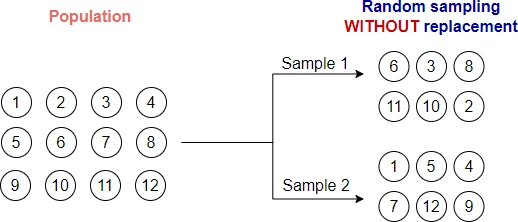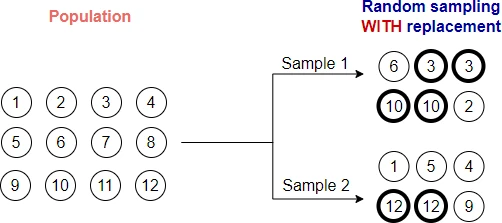Understanding random sampling with and without replacement (with python code)
Statistics and machine learning rely heavily on random sampling (or simple random sampling). Basically, random sampling refers to the selection of observations from a large dataset (population) at random, where each observation has an equal chance of being chosen.
For example, in a bag of 100 balls, if we select any 10 balls and every ball has an equal chance of selection, then it is called a random sample.
Simple Random sampling can be divided into sampling without replacement and sampling with replacement based on the method of selection.
Sampling without replacement
In sampling without replacement method, the samples are selected randomly from the original dataset (population) without any replacement. That is if one sample is selected, it will not be selected again.

For example, in a bag of 10 balls, we can have two random samples of 5 balls. Every ball has an equal chance of selection.
Let’s perform random sampling without replacement using random.sample() function in Python
from random import sample
# list of 10 balls
bag = list(range(1, 11))
# output
[1, 2, 3, 4, 5, 6, 7, 8, 9, 10]
# select random sample of size 5 (without replacement)
sample(bag, 5)
# output
[2, 5, 8, 6, 4]
In the above example, you can see sample of size 5 drawn randomly without replacement from a bag of 10 balls.
Sampling with replacement
In the sampling with replacement method, the samples are selected randomly from the original dataset (population) with possible replacement. That is if one sample is selected, it may be selected again.

For example, in bag of 10 balls, we can select one ball randomly and make a record of it. Then put that back again in the bag and select second ball. Repeat the process until required size of sample. In this sampling, there is chance that same ball can be selected multiple times.
Let’s perform random sampling without replacement using random.choices() function in Python
from random import choices
# bag of 10 balls
bag = list(range(1, 11))
# output
[1, 2, 3, 4, 5, 6, 7, 8, 9, 10]
# select random sample of size 5 (with replacement)
choices(bag, k=5)
# output
[10, 8, 6, 10, 8]
In the above example, you can see a sample of size 5 drawn randomly with replacement (some balls are repetitive) from a bag of 10 balls.
Enhance your skills with courses on machine learning
- Advanced Learning Algorithms
- Machine Learning Specialization
- Machine Learning with Python
- Machine Learning for Data Analysis
- Supervised Machine Learning: Regression and Classification
- Unsupervised Learning, Recommenders, Reinforcement Learning
- Deep Learning Specialization
- AI For Everyone
- AI in Healthcare Specialization
- Cluster Analysis in Data Mining
If you have any questions, comments or recommendations, please email me at reneshbe@gmail.com
This work is licensed under a Creative Commons Attribution 4.0 International License
Some of the links on this page may be affiliate links, which means we may get an affiliate commission on a valid purchase. The retailer will pay the commission at no additional cost to you.

